We’d like to remind Forumites to please avoid political debate on the Forum.
This is to keep it a safe and useful space for MoneySaving discussions. Threads that are – or become – political in nature may be removed in line with the Forum’s rules. Thank you for your understanding.
UKPC DCB Legal court claim - Not parking within marking of bay
Comments
-
I wouldn't mention it much in the defence. Certainly don't admit to parking over lines.
Use the Template Defence (the usual one without Chan & Akande).PRIVATE 'PCN'? DON'T PAY BUT DON'T IGNORE IT (except N.Ireland).
CLICK at the top or bottom of any page where it says:
Home»Motoring»Parking Tickets Fines & Parking - read the NEWBIES THREAD1 -
please can you comment on the statement below, everything else will be adapted from the WS I linked previously, focusing on signage and removing any references to POCs:
Due to the inadequate total number of allocated parent/child spaces within the car park, and therefore available that day, I had no other option other than to park in a non-parent/child bay which is not sufficient in size to wholly accommodate my vehicle and requirements (safe entry/exit for my 4 month old baby at the time who was positioned in the back left seat, nearest the wall). I parked in the end bay ensuring no other users could block entry to the vehicle, with the absolute minimum amount of space to get a baby in and out of the vehicle safely. The space in which I parked is partially obstructed by a kerb, which reduces the overall size and shape of the bay to 2.2m (approximately 10cm smaller than the other bay sizes and 20cm smaller than common standard of 2.4m wide). This kerb also makes it very distracting / difficult to get in and out of the space without damaging the vehicle.
When reversing into the space, I was concentrating on just leaving enough space to get my baby out of the vehicle at the same time as avoiding the obscure kerb. I did not notice that the vehicle was parked over the line marking the bay, and due to the poorly communicated terms and conditions (paragraphs…) I was not aware this was a parking violation. My Mitsubishi ASX is 1.81m wide leaving just 39cm of additional room to comply with the poorly communicated terms and conditions. This is not enough room for an adult to get out of the vehicle, and certainly not enough room to safely get baby out of the vehicle. As you can see in the evidence photo provided by there claimant, I had to push my left wing mirror in to get access to my child, even taking into account the position to the vehicle in relation to the ‘bay’.
Once parked I exited the vehicle, got my young baby out of the car, put him in the pushchair and exited the car park via the designated pedestrian zones , upon returning to the carpark, I paid the correct fee and exited the car park.
0 -
I'm writing the witness statement, not the defence. I will remove any references to parking over the lines as mentioned. I assumed this was acceptable as long as I did not do this intentionally/knowingly (there is a photo of it).Coupon-mad said:I wouldn't mention it much in the defence. Certainly don't admit to parking over lines.
Use the Template Defence (the usual one without Chan & Akande).
anything else from the above that I should add/remove?
thanks.0 -
I'd remove this:
"When reversing into the space, I was concentrating on just leaving enough space to get my baby out of the vehicle at the same time as avoiding the obscure kerb. I did not notice that the vehicle was parked over the line marking the bay, and due to the poorly communicated terms and conditions (paragraphs…) I was not aware this was a parking violation."PRIVATE 'PCN'? DON'T PAY BUT DON'T IGNORE IT (except N.Ireland).
CLICK at the top or bottom of any page where it says:
Home»Motoring»Parking Tickets Fines & Parking - read the NEWBIES THREAD1 -
Can you please take a look and comment on my draft WS below. As mentioned previously I adapted the bundles available online, removing references to POCs etc.
In other example WS there are many examples of strikeouts due to POCs. Is there anything similar I should include more relevant to signage? I had to remove the whole section.
I haven't included all images, but I returned to the car park, to demonstrate it's impossible to access a baby if parked inside the bay with measurements, + additional pictures of all poor examples of the T&C sign.
Ignore the numbering/formatting due to copy and paste.
thank you in advance!WITNESS STATEMENT OF DEFENDANT
I am xxx, and I am the Defendant against whom this Claim is made. The facts below are true to the best of my belief and my account has been prepared based on my own knowledge.
In my Statement I shall refer to Exhibits 01-07 within the evidence supplied with this Statement, referring to page and reference numbers where appropriate. My Defence is repeated, and I will say as follows:
Facts and sequence of events
Date and time of the Incidents: It is admitted that on xxx I was the registered keeper of the vehicle xxx and I was driving on this occasion.
Parking Notice: The Claimant pursues a claim for not parking wholly within a bay. I do recognise the location of the alleged parking violation as being at the xxxx.
Inadequate number of parent/child spaces: Due to the inadequate total number of allocated parent/child spaces within the car park, and therefore available that day (5 total parent/child bays for the whole 5 story car park, see Exhibit 01), I had no other option other than to park in a non-parent/child bay which is not sufficient in size to wholly accommodate my vehicle and requirements (safe entry/exit for my 4 month old baby at the time who was positioned in the back left passenger seat, nearest the wall).
Inadequate sized and obscure shaped bay: I parked on the 4th floor in an end bay ensuring no other users could block entry to the vehicle, with the absolute minimum amount of space to get a baby in and out of the vehicle safely. The space in which I parked is partially obstructed by a kerb, which reduces the overall size and shape of the bay to 2.1m, 30cm smaller than the UK norm of 2.4m wide according to the British Parking Association (https://www.britishparking.co.uk/write/Documents/Library%202016/Bay_Sizes_-_Jul_2016.pdf). The kerb also makes it very distracting / difficult to get in and out of the space without damaging the vehicle (See Exhibit 2).
My Mitsubishi ASX is 1.81m wide leaving just 29cm (see Exhibit 2) of additional room to comply with the poorly communicated terms and conditions (paragraphs 8-10) . This is not enough room for an adult to get out of the vehicle, and impossible to get a baby seat out of the vehicle (See Exhibit 2) . As seen in the evidence photo provided by the claimant, I had to push my left wing mirror in to get access to my child, even taking into account the position of the vehicle.
Once parked, I exited the vehicle, took the baby seat out of the car, attached it to the pushchair and exited the car park via the designated pedestrian zone. Upon returning to the carpark, I paid the correct fee and exited the car park.
Inadequate signage: I have observed a lack of clear and visible signage regarding parking regulations. The only signs that are visible at the entrance to the car park building, which is otherwise unmarked, give no information whatsoever as to the nature of the Terms and Conditions, merely ‘see notices in car park for terms and conditions’. Even the text which provides this limited information is very small and not clearly legible from inside a moving vehicle (see Exhibit 3)
The only signs which do provide information relating to the Terms and Conditions are printed in such small type as to be illegible unless very close (see Exhibit 4). The only readable element of this sign is the part which states ‘pay on exit’. All instances of this sign are are poorly positioned throughout the car park in locations which are not visible to any car entering the car park, or from the clearly marked pedestrian zones.The the location of this sign are as follows:
positioned to the left of the barriers, which is obscured from view behind other cars entering the car park (2 lanes).
positioned on the left wall on each floor as you're driving round a tight right hand bend, the opposite direction a sensible driver is looking when driving a vehicle round a tight right hand corner (see Exhibit 4.b).
The sign closest to my parked vehicle was on a ramp to the rooftop floor of the car park and is impossible to see when the light from outside is reflecting off it. It is also impossible to see the text without standing on the ramp itself which is a clearly marked no pedestrian zone (see Exhibit 4.c).
The only other examples of this sign are positioned behind car parking spaces, obstructed by parked cars (see Exhibit 4.d).
The poor placement and legibility of these signs made it extremely difficult for anybody to be aware of or to comply with the parking rules. This is in stark contrast to the highly visible, clear and legible signs seen in ParkingEye v Beavis [2015] UKSC67 (“the Beavis case”). (See Exhibit 6).
0 -
Exaggerated Claim and “market failure” currently examined by UK Government
The alleged “core debt” from any parking charge cannot have exceeded £100 (the industry cap set out in the IAS Code of Practice). I have seen no evidence that the added damages/fees are genuine.
I say that fees were not paid out or incurred by this Claimant, who is put to strict proof of:
The alleged breach, and
A breakdown of how they arrived at the enhanced amount claimed.
This Claimant routinely pursues a disproportionate additional fixed sum (inexplicably added per PCN) despite knowing that the will of Parliament is to ban or substantially reduce the disproportionate “debt fees”. The case is a classic example where the unjust enrichment of exaggerated feeds encourages the “numbers game” of inappropriate and out of control bulk litigation of weak or archive parking cases. No pre-action checks and balances are likely to have been made to ensure facts, merit, position of signs/the vehicle, or a proper cause of action.
The Department for Levelling Up, Housing and Communities (the DLUHC) first published its statutory Parking Code of Practice on the 7th of February 2022,here: https://www.gov.uk/government/publications/private-parking-code-of-practice. “Private firms issue roughly 22,000 parking tickets every day, often adopting a labyrinthine system of misleading and confusing signage, opaque appeals services, aggressive debt collection and unreasonable fees designed to extort money from motorists.”
Despite legal challenges delay the Code’s implementation (marking it as temporarily “withdrawn” as shown in the link above) a draft Impact Assessment (IA) to finalise the DLUHC Code was recently published on the 30th of July 2023, which has exposed some industry-gleaned facts about supposed “debt fees”. This is revealed in the Government’s analysis, found here: https://assets.publishing.service.gov.uk/government/uploads/system/uploads/attachme nt_data/file/1171438/Draft_IA_-_Private_Parking_Code_of_Practice_.pdf
Paragraphs 4.31 and 5.19 reveal that the parking industry has informed the DLUHC that the true minor cost of what the parking industry likes to call debt recovery or “enforcement” (pre-action) stage totals a mere £8.42 per recovery case. 19. With that sum in mind, the extant claim has been enhanced by an excessive amount, disingenuously added as an extra “fee”. This is believed to be routinely retained by the litigating legal team and has been claimed in addition to the intended “legal representatives fees” cap set within the small claims track rules. This conduct has been examined and found – including in a notably detailed judgment by Her Honour Judge Jackson, now a specialist Civil High Court Judge on the Leeds/Bradford circuit – to constitute “double recovery” and I take that position.
The new draft IA now demonstrates that the unnecessarily intimidating stage of pre action letter-chains costs “eight times less” (says the DLUHC analysis) than the price fixed £70 per PCN routinely added. This has caused consumer harm in the form of hundreds of thousands of inflated CCJs each year that District Judges have been powerless to prevent. This abusively enhanced “industry standard” Debt Fee was enabled only by virtue of the self-serving Codes of Practice of the rival parking Trade Bodies, influenced by a Board of parking operators and their debt firms who stood to gain from it. In support of my contention that the sum sought is unconscionably exaggerated and thus unrecoverable, attention is drawn to paras 98, 100, 193, 198 of Beavis. Also, ParkingEye Ltd. v Somerfield Stores Ltd. ChD [2011] EWHC4023(QB) where the parking charge was £75, discounted to £37.50 for prompt payment. Whilst £75 was reasonable, HHJ Hegarty (decision later ratified by the CoA) held in paras 419-428 that unspecified “admin costs” inflating a parking charge to £135 was not a true reflection of the cost of a template letter and “would appear to be penal”.
This Claimant has not incurred any additional costs because the full parking charge (after expiry of discount) is already high and more than covers what the Supreme Court called an “automated-letter-chain” business model that generates a healthy profit. In Beavis, there were 4 or 5 letters in total, including pre-action phase reminders. The £85 parking charge was held to cover the “costs of the operation” and the DLUHC’s IA suggests it should still be the case that the parking charge itself more than covers the minor costs of pre-action stage, even if and when the Government reduces the level of parking charges.
Whilst the new Code is not retrospective, the majority of the clauses went unchallenged by the parking industry, and it stands to become a creature of statute due to the failure of the self-serving BPA & IPC Codes. The DLUHC’s Secretary of State mentions they are addressing “market failure” more than once in the draft IA, a phrase which should be a clear steer for Courts in 2024 to scrutinise every aspect of claims like this one.
In addition, pursuant to Schedule 4 Paragraph 4(5) of the Protection of Freedoms Act 2012 (“the POFA”), the sum claimed exceeds the maximum potentially recoverable. It is also disproportionate and in breach of the Consumer Rights Act 2015 (the CRA).
CRA breaches
Claiming costs on an indemnity basis is unfair, per the Unfair Contract Terms Guidance (CMA37, para 5.14.3), the Government guidance on the CRA which introduced new requirements for “prominence” of both contract terms and “consumer notices”. In a parking context, this includes a test of fairness and clarity of signage, and all notices, letters and other communications intended to be read by the consumer.
Section 71 creates a duty upon courts to consider the test of fairness, including (but not limited to) whether all terms/notices were unambiguously and conspicuously brought to the attention of a consumer. Signage must be prominent, plentiful, well placed (and lit in hours of dusk/darkness) and all terms must be unambiguous and contractual obligations clear.
The CRA has been breached due to unfair/unclear terms and notices, pursuant to s62 and paying due regard to examples 6, 10, 14 & 18 of Schedule 2 and the requirements for fair/open dealing and good faith (NB: this does not necessarily mean that there has to be a finding of bad faith).
Now for the first time, the DLUHC’s draft IA exposes that the template “debt chaser” stage costs less than £9. This shows that HHJ Jackson was right all along in Excel v Wilkinson. (See Exhibit 5)
The Beavis case is against this Claim
The Supreme Court clarified that “the penalty rule is plainly engaged” in parking cases, which must be determined on their own facts. That “unique” case met a commercial justification test, given the location and clear signs with the charges in the largest/boldest text. Rather than causing other parking charges to be automatically justified, that case, particularly the brief, conspicuous yellow and black warning signs – (See Exhibit 6) – set a high bar that this Claimant has failed to reach.
Paraphrasing from the Supreme Court, deterrence is likely to be penal if there is a lack of a “legitimate interest” in performance extending beyond the prospect of compensation flowing directly from the alleged breach. The intention cannot be to punish a driver, nor to present them with hidden terms, unexpected/cumbersome obligations not “concealed pitfalls or traps”. (See Exhibit 07) for paragraphs from the Beavis case.)
In the present case, the Claimant has fallen foul of these tests. There is one main issue that renders this parking charge to be purely penal (i.e. no legitimate interest saves it) and thus, it is unenforceable:
Hidden Terms: The £100 penalty clause is positively buried in small print, as seen on the signs in evidence. The purported added (false) “costs” are even more hidden and are also unspecified as a sum. Their (unlawful, due to the CRA Schedule 2 grey list of unfair terms) suggestion is that they can hide a vague sentence within a wordy sign, in the smallest possible print, then add whatever their Trade Body lets them, until the Government bans it. The driver thus has no idea about any risk, nor even how much may be added on top. Court of Appeal authorities which are on all fours with a case involving a lack of “adequate notice” of a charge include:
Spurling v Bradshaw [1956] 1 WLR 461 (“red hand rule”) and
Thornton v Shoe Lane Parking Ltd. [1970] EWCA Civ2, both leading authorities confirming that a clause cannot be incorporated after a contract has been concluded; and
Vine v London Borough of Waltham Forest: CA 5 Apr 2000, where Ms Vine won because it was held that she had not seen the terms by which she would later be bound, due to “the absence of any notice on the wall opposite the parking space”.
Conclusion
In conclusion, the Claimant has failed to provide clear evidence that a contract was formed, nor has it shown that the parking charge notices were validly issued. The lack of adequate signage and the unlawful nature of the additional charges further invalidate the Claim. The Claimant’s attempt to impose liability for these inflated charges is unsupported by both statutory law and leading case precedents. I ask the court to dismiss the Claim and award appropriate costs for the time and effort expended in defending against these unjust claims.
There is now ample evidence to support the view – long held by many District Judges – that these are knowingly inflated claims. The July 2023 DLUHC IA analysis surely makes that clear, because it is now a matter of record that the industry has told the Government that “debt recovery” costs eight times less than they have been claiming in almost every case. For HMCTS to only disallow those costs in the tiny percentage of cases that reach hearings whilst other claims continue to flood the courts unabated, is to fail hundreds of thousands of consumers who suffer CCJs or pay inflated amounts, in fear of the intimidating pre-action demands. I strongly believe that it is in the public interest that claims like this should be struck out, because knowingly enhanced parking claims like this one cause consumer harm on a grand scale.
Attention is drawn specifically to the (often seen from this industry) possibility of an unreasonably late Notice of Discontinuance. Whilst CPR r.38.6 states that the Claimant is liable for the Defendant’s costs after discontinuance (r.38.6(1)) this does not normally apply to claims allocated to the small claims track (r.38.6(3)). However, the White Book states (annotation 38.6.1) “Note that the normal rule as to costs does not apply if a claimant in a case allocated to the small claims track serves a Notice of Discontinuance although it might be contended that costs should be awarded if a party has behaved unreasonably (r.27.14(2)(dg)).”
Costs Assessment
Given the significant time and effort required to defend against this unjust claim, I respectfully request that the court consider awarding costs under CPR 27.14(2)(g). I have spent considerable time researching, preparing this Statement, and attending the hearing. My estimated costs for this are as follows:
- Research and preparation of Defence and Witness Statement (8 hours): £80
- Travel expenses (return journey to hearing via taxi): £40
- Childcare: £100
Totalling £220
I request that the court considers these costs in its Judgment, given the Claimant’s unreasonable behaviour in pursuing this meritless Claim.
Statement of Truth
I believe that the facts stated in this Witness Statement are true. I understand that proceedings for contempt of court may be brought against anyone who makes, or causes to be made, a false statement in a document verified by a statement of truth without an honest belief in its truth.
Defendant’s Signature:
Date:
0 -
Remove all the DLUHC paragraphs if that was already in your defence. What photos of their signs are you attaching?PRIVATE 'PCN'? DON'T PAY BUT DON'T IGNORE IT (except N.Ireland).
CLICK at the top or bottom of any page where it says:
Home»Motoring»Parking Tickets Fines & Parking - read the NEWBIES THREAD0 -
Pls see below.All photos (except the close up) are taken from either perspective of car travelling to space, or pedestrian exiting the car park.Should I include the close up view so it’s comparable to beavis?
There’s also another photo of the sign on a ramp nearest my car which is not visible. I couldn’t easily edit out my reg on my phone so left it out below.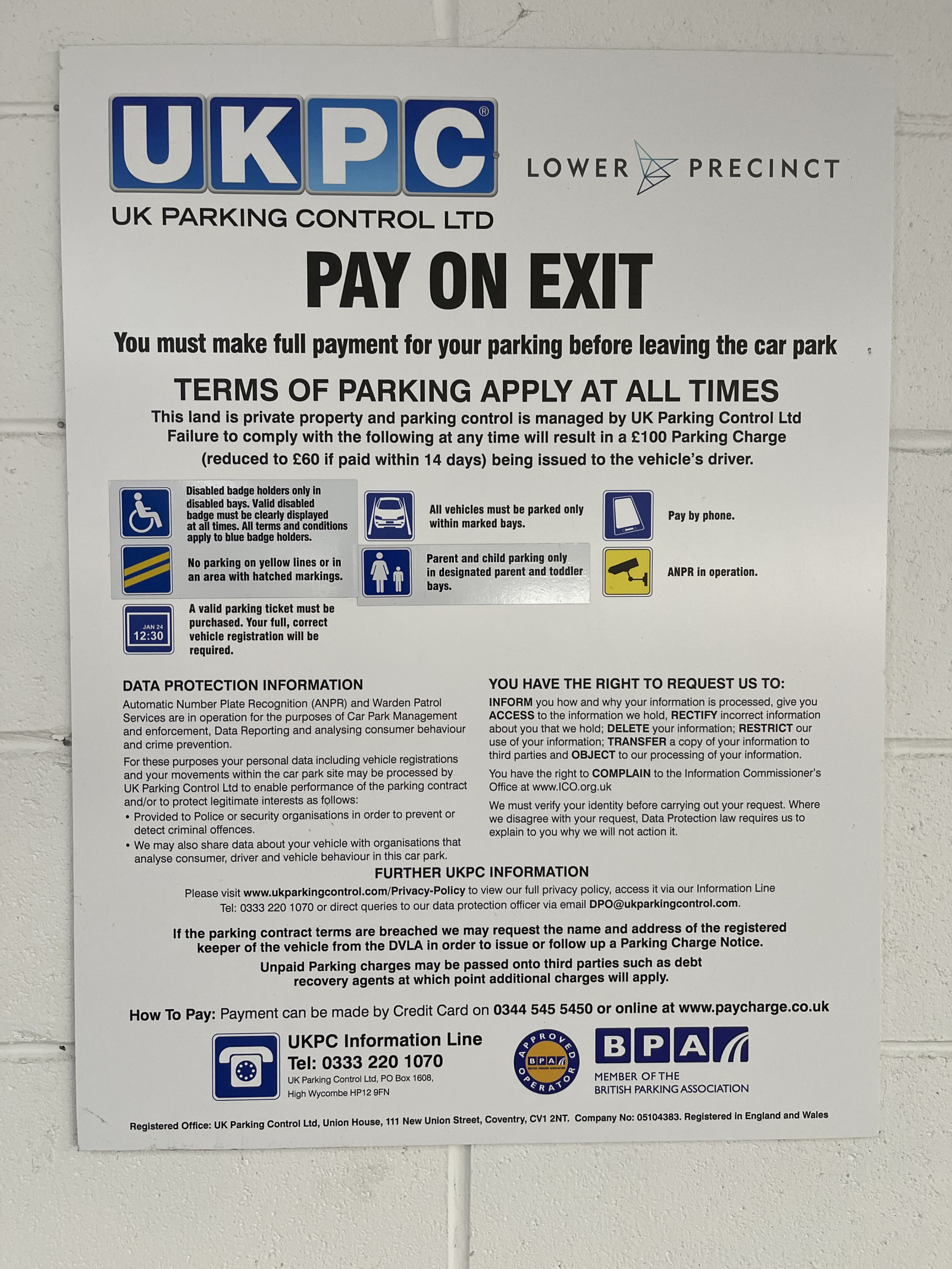
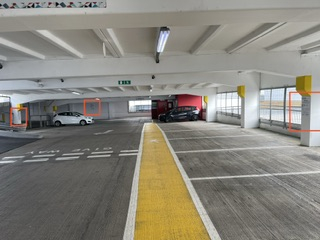
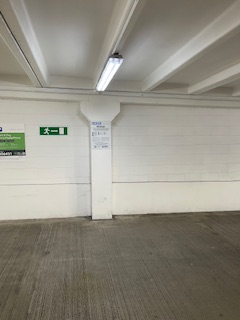
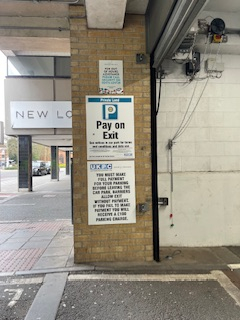
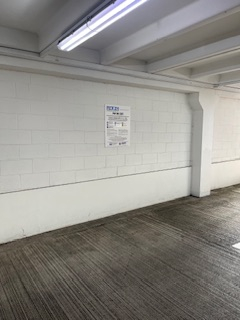
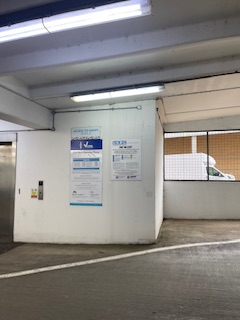
0 -
Coupon-mad said:It's not a "curb". Arrrgh! Sorry. We aren't in the USA. A wrong spelling that grates with me.
Remove this too:"demonstrating that it was impossible to comply with the poorly defined / communicated terms and conditions."
Should definitely curb that spelling!0 -
I'd remove the close up.PRIVATE 'PCN'? DON'T PAY BUT DON'T IGNORE IT (except N.Ireland).
CLICK at the top or bottom of any page where it says:
Home»Motoring»Parking Tickets Fines & Parking - read the NEWBIES THREAD0
Confirm your email address to Create Threads and Reply

Categories
- All Categories
- 353K Banking & Borrowing
- 254K Reduce Debt & Boost Income
- 454.8K Spending & Discounts
- 246.1K Work, Benefits & Business
- 602.2K Mortgages, Homes & Bills
- 177.8K Life & Family
- 260.1K Travel & Transport
- 1.5M Hobbies & Leisure
- 16K Discuss & Feedback
- 37.7K Read-Only Boards



